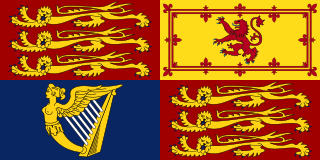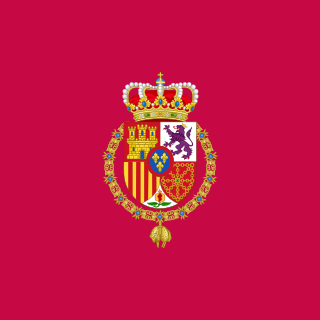See also
| This article includes a list of related items that share the same name (or similar names). If an internal link incorrectly led you here, you may wish to change the link to point directly to the intended article. |
Royal standard, royal flag, or royal banner may refer to:
Several countries use the term royal standard to describe the flag used by the monarch and members of the royal family:
| This article includes a list of related items that share the same name (or similar names). If an internal link incorrectly led you here, you may wish to change the link to point directly to the intended article. |

Mahārāja is a Sanskrit title for a "great ruler", "great king" or "high king". A few ruled mighty states informally called empires, including ruler Maharaja Ranjit Singh, founder of the Sikh Empire, and Maharaja Sri Gupta, founder of the ancient Indian Gupta Empire, but 'title inflation' soon led to most being rather mediocre or even petty in real power, while compound titles were among the attempts to distinguish some among their ranks.

The flag of England is derived from Saint George's Cross. The association of the red cross as an emblem of England can be traced back to the Middle Ages, and it was used as a component in the design of the Union Flag in 1606. Since the 1990s it has been in increasingly wide use, particularly at national sporting events.

The royal coat of arms of the United Kingdom, or the Royal Arms for short, is the official coat of arms of the British monarch, currently Queen Elizabeth II. These arms are used by the Queen in her official capacity as monarch of the United Kingdom. Variants of the Royal Arms are used by other members of the British royal family, by the British Government in connection with the administration and government of the country, and some courts and legislatures in a number of Commonwealth realms. In Scotland, there exists a separate version of the Royal Arms, a variant of which is used by the Scotland Office and the Judiciary. The arms in banner form serve as basis for the monarch's official flag, known as the Royal Standard.

The Governor-general of India was the representative of the monarch of the United Kingdom and after Indian independence in 1947, the representative of the Indian head of state. The office was created in 1773, with the title of Governor-general of the Presidency of Fort William. The officer had direct control only over Fort William, but supervised other East India Company officials in India. Complete authority over all of British India was granted in 1833, and the official came to be known as the "governor-general of India".

The Royal Standards of the United Kingdom refers to either one of two similar flags used by Queen Elizabeth II in her capacity as Sovereign of the United Kingdom and its overseas territories. Two versions of the flag exist, one for general use in England, Northern Ireland, Wales and overseas; and the other for use in Scotland.

The Royal Arms of England are the arms first adopted in a fixed form at the start of the age of heraldry as personal arms by the Plantagenet kings who ruled England from 1154. In the popular mind they have come to symbolise the nation of England, although according to heraldic usage nations do not bear arms, only persons and corporations do. The blazon of the Arms of Plantagenet is: Gules, three lions passant guardant in pale or armed and langued azure, signifying three identical gold lions with blue tongues and claws, walking past but facing the observer, arranged in a column on a red background. Although the tincture azure of tongue and claws is not cited in many blazons, they are historically a distinguishing feature of the Arms of England. This coat, designed in the High Middle Ages, has been variously combined with those of the Kings of France, Scotland, a symbol of Ireland, the House of Nassau and the Kingdom of Hanover, according to dynastic and other political changes occurring in England, but has not altered since it took a fixed form in the reign of Richard I (1189–1199), the second Plantagenet king.

The flag of Spain, as it is defined in the Spanish Constitution of 1978, consists of three horizontal stripes: red, yellow and red, the yellow stripe being twice the size of each red stripe. Traditionally, the middle stripe was defined by the more archaic term of gualda, and hence the popular name rojigualda (red-weld).

The flag of Sri Lanka, also called the Lion Flag or Sinha Flag, consists of a gold lion holding a kastane sword in its right fore-paw in a maroon background with four gold bo leaves, one in each corner. This is bordered by gold, and to its left are two vertical stripes of equal size in green and orange, with the orange stripe closest to the lion. The lion and the maroon background represent the Sinhalese, while the saffron border and four Bo leaves represent Buddhism and the four Buddhist concepts of Mettā, Karuṇā, Muditā and Upekshā respectively. The stripes represent the two main minorities: the orange representing the Sri Lankan Tamils and the green representing Sri Lankan Muslims.
The Royal Standards of Canada are a set of uniquely Canadian personal flags approved by the Queen of Canada for use by members of the Canadian Royal Family. They are used to denote the presence of the bearer within any car, ship, airplane, building, or area, within Canada or when representing Canada abroad. There are six personal royal standards, one each for the Queen, the Prince of Wales, the Duke of Cambridge, the Princess Royal, the Duke of York, and the Earl of Wessex, as well as one standard for use more generally to denote the presence of any member of the Royal Family who has not previously been provided with a specific personal standard. The flags are part of a larger collection of Canadian royal symbols.

A princely state, also called native state, feudatory state or Indian state, was a vassal state under a local or indigenous or regional ruler in a subsidiary alliance with the British Raj. Though the history of the princely states of the subcontinent dates from at least the classical period of Indian history, the predominant usage of the term princely state specifically refers to a semi-sovereign principality on the Indian subcontinent during the British Raj that was not directly governed by the British, but rather by a local ruler, subject to a form of indirect rule on some matters. The imprecise doctrine of paramountcy allowed the government of British India to interfere in the internal affairs of princely states individually or collectively and issue edicts that applied to all of India when it deemed it necessary.

The Welsh Dragon is a heraldic symbol that appears on the national flag of Wales. The oldest recorded use of the dragon to symbolise Wales is in the Historia Brittonum, written around AD 829, but it is popularly supposed to have been the battle standard of King Arthur and other ancient Celtic leaders. Its association with these leaders, along with other evidence from archaeology, literature, and documentary history, led many to suppose that it evolved from an earlier Romano-British national symbol. During the reigns of the Tudor monarchs, the red dragon was used as a supporter in the English Crown's coat of arms. The red dragon is often seen as symbolising all things Welsh, and is used by many public and private institutions. These include the Welsh Government, Visit Wales, and numerous local authorities including Blaenau Gwent, Cardiff, Carmarthenshire, Rhondda Cynon Taf, Swansea, and sports bodies, including the Sport Wales National Centre, the Football Association of Wales, Wrexham A.F.C., Newport Gwent Dragons, and London Welsh RFC, while the "dragon's tongue" is the symbol of the Welsh Language Society. The Welsh Dragon is also one of The Queen's Beasts.

The Royal Banner of the Royal Arms of Scotland, also known as the Royal Banner of Scotland, or more commonly the Lion Rampant of Scotland, and historically as the Royal Standard of Scotland, or Banner of the King of Scots, is the Royal Banner of Scotland, and historically, the Royal Standard of the Kingdom of Scotland. Used historically by the Scottish monarchs, the banner differs from Scotland's national flag, the Saltire, in that its correct use is restricted by an Act of the Parliament of Scotland to only a few Great Officers of State who officially represent the Monarchy in Scotland. It is also used in an official capacity at royal residences in Scotland when the Head of State is not present.

A salute state was a princely state under the British Raj during the time of British rule which had been granted a gun salute by the British Crown ; i.e., the protocolary privilege for its ruler to be greeted—originally by Royal Navy ships, later also on land—with a number of cannon shots, in graduations of two salutes from three to 21, as recognition of the state's relative status. The gun-salute system of recognition was first instituted during the time of the East India Company in the late 18th century and was continued under direct Crown rule from 1858.

The Royal Standard of Spain is the official flag of the King of Spain. It comprises a crimson square, traditional colour of both Castilian and Spanish monarchs, with the coat of arms of the King in the center. It is raised over the official royal residence in Madrid, the Palacio de la Zarzuela and other Spanish royal sites, when the monarch is in residence and displayed on his official car as small flag. The current flag was adopted when Felipe VI acceded the throne as King of Spain on 19 June 2014. The Royal Standard is regulated by Rule 2 of Royal Decree 527/2014, 20 June, an amendment to Title II of Spanish Royal Decree 1511/1977 adopting Flags, Standards, Guidons, Insignia and Emblems Regulation.

In heraldry and vexillology, a heraldic flag is a flag containing coats of arms, heraldic badges, or other devices used for personal identification.

Queen Elizabeth II has and has had a variety of flags to represent her personally and as head of state of 16 independent nations around the world. They are usually used on any building, ship, car, or aircraft where she is present.

Kolhapur State or Kolhapur Maratha Kingdom (1710–1949) was a Maratha princely State of British India, under the Deccan Division of the Bombay Presidency, and later the Deccan States Agency. It was considered the most important of the Maratha principalities with the others being Baroda State, Gwalior State and Indore State. Its rulers, of the Bhonsle dynasty, were entitled to a 19-gun salute – thus Kolhapur was also known as a 19-gun state. The state flag was a swallow-tailed saffron pennant.

Kingdom of Bharatpur was a Hindu kingdom in the Indian subcontinent. It was ruled by the Jats of Sinsinwar gotra.

Indore State, also known as Holkar State, was a royal state in India. Its rulers belonged to the Holkar dynasty. Indore was a 19-gun salute princely state during the British rule in India.

The Chhota Udaipur State or 'Princely State of Chhota Udaipur', was a princely state with its capital in Chhota Udaipur during the era of British India. The last ruler of Chhota Udaipur State signed the accession to join the Indian Union in 1948. Chhota Udepur shares a history with Devgadh Baria and Rajpipla as one of the three princely states of eastern Gujarat.